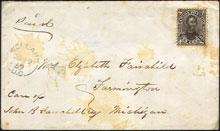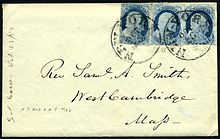In addition to collecting individual stamps, many people also specialize in collecting different forms of postal material. One form of postal material is a First Day Cover. Although interest in collecting modern First Day Covers has somewhat diminished nowadays, it is still quite popular in many circles. So, what is a First Day Cover (FDC)? What is the difference between a FDC and a regular cover?

OK, let’s start by defining a cover. Basically, a cover is a stamped and addressed envelope that has gone through the mail service and bears the post office’s postmark. This marking can include such things as the date and location of the post office. Some collectors like to collect these envelopes; sometimes the letter or contents of the envelope are still contained inside, but it is actually the information and the stamp outside of the envelope which interests collectors.

Obviously, as with individual stamp collecting, old covers are especially interesting. Some older covers are from an era before envelopes were used. In the past, when people wrote their letters, they would wrap the letter up in a separate, clean sheet of paper. Then, they would fold everything up together and seal it shut with sealing wax or some other adhesive. On the front of the «cover» sheet (so now you know where a cover gets its name from), the sender would write the destination address and affix the stamp. These stamped sheets are also considered covers just the way an envelope is.
Covers can be fun and interesting. I have personally handled some very old ones and its interesting to see the elegant handwriting (why was handwriting was more of an art in the past than it is today?), read the names on the envelope, check the location of the post office on a map and catalog the stamp. If the letter is still inside, even better! Although that doesn’t happen very often.

What then is a First Day Cover? It is a special variety of cover. Many different cover varieties exist such as special event covers, first flight covers, crash covers, commemorative covers, military covers and historical covers-but that’s a whole other article!
In the simplest terms, a FDC is an envelope bearing a postage stamp (or a series of stamps) that has been cancelled by the post office on the first day of issue of that particular stamp. Basically, it’s the cancellation date and how it relates to the stamp that makes a FDC different from a regular cover. Generally, the words «First Day of Issue» are also been stamped on the envelope by the post office. Technically, a FDC can be made by a private individual or issued by Canada Post. When FDCs first appeared in the early 1900s, they were a special item created by enterprising philatelists and collectors.
FDCs are also different in that they sometimes have a «cachet». What is a cachet? Often, when a FDC commemorates a place or an event, additional artwork is drawn on the envelope, usually on the left hand side (see FDC above-the cachet is the maple leaf image). This artwork features supplementary information about the event or the subject of the stamp. At the height of FDC making, some private collectors and dealers became reputable «cachet-makers»-their designs were so popular that they would make their own stylized FDCs and sell them to the public. In later years, Canada Post began issuing its own cacheted FDCs, which led to the gradual disappearance of private cachet-makers. Now, Canada Post releases Official First Day Covers (OFDC) and continues to issue several of them throughout the year to this day.
For example, on August 6, 2012, Canada Post issued an OFDC commemorating the Alouettes of Montreal. A commemorative Montreal Alouettes stamp is featured on an envelope bearing all over artwork (which is the cachet) related to the Grey Cup and the stamp was cancelled in Montreal, QC, the home of the Alouettes.
Therefore, modern FDCs often have a special stamp, special cachet, they are cancelled in a city or town related to the event or subject of the stamp. Occasionally, the cancellation itself is specially designed to reflect the subject matter (for example, the cancellation on the OFDC featuring a stamp of Governor General Roméo Leblanc was Leblanc’s own signature).
So, have fun with covers and First Day Covers. They are interesting, educational and sometimes historical. Check out these Canada FDC collections on our Collections page at Arpin Philately.
are FDC worth anything? I have 1 that was received by my grandfather in the early 60s I think. Do collectors look for FDC’s as well?
This may seem obvious to collectors, but to clearly ask so I can get a clear answer: the postmark stamped on a first day cover is a cancellation, meaning a first day cover cannot be posted anywhere at some later date – is that correct?
YES YOU CAN, but not advisable as you will damage the provenance of the origiinal historic cover to which you speak about. Nevertheless, I believe you may have to add and update your postage to current rates and value to the cover you want to sent. This will also mean the likelihood that obliverating CANCELS may be applied to the cover and the stamps thereon to authendicate proper postage and new “CURRENT” day of delivery of your cover letter by the issuing postal authority.
Go to the site below to see an example of the FDC to which I write about:
https://canadafdc.org/Gallery/v/MemberAlbums/mphilatelicorner/Makeup+Postage+Stamps+on+Cover/
Member Albums michael thomas ERD [Earliest Recorded Date] use of the 2014 $0.22-cent (Monarch Butterfly) on Cover ERD of Canada’s “make-up” $0.22 cent postage (Butterfly) stamp on cover